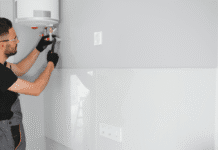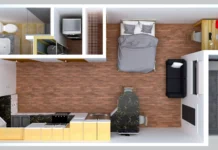Last Updated on January 14, 2026 by Rida Gul
Modern bathroom design has come a long way from its utilitarian origins, evolving into a space that embodies luxury, relaxation, and personal style. In 2024, the trends in bathroom design reflect a blend of technology, sustainability, and aesthetics, catering to diverse tastes and preferences. This transformation is driven by a desire for functionality without compromising on beauty, creating sanctuaries within homes where individuals can unwind and rejuvenate.
Table of Contents
The Evolution of Modern Bathroom Design
Historically, bathrooms were designed with a focus on practicality, often featuring basic fixtures and minimal decoration. However, the contemporary approach to bathroom design is holistic, considering not only the functional aspects but also the ambiance and user experience. This shift is influenced by various factors, including advancements in technology, growing environmental consciousness, and an increased appreciation for interior design.
Today’s modern bathrooms are characterized by clean lines, innovative materials, and sophisticated color palettes. The integration of smart technology, such as touchless faucets and digital showers, enhances convenience and efficiency. Eco-friendly designs are gaining popularity as homeowners seek sustainable solutions that reduce water consumption and promote energy efficiency. The use of natural materials, like stone and wood, adds warmth and a connection to nature, creating a serene atmosphere.
Personal Trends for Bathroom Remodeling in 2024
Personalization is another key trend, with customizable features allowing homeowners to tailor their bathrooms to their unique needs and preferences. From custom vanities to bespoke lighting fixtures, the possibilities are endless. The result is a bathroom that not only meets practical requirements but also serves as a personal retreat.
As we explore the top modern bathroom designs for 2024, we’ll delve into specific trends and ideas that inspire and elevate the bathroom experience. Whether you’re planning a complete remodel or looking to update certain elements, these insights will help you create a space that is both functional and visually stunning.
Sustainable and Eco-Friendly Bathroom Designs 2024
In recent years, there has been a significant shift towards sustainability in home design, and bathrooms are no exception. In 2024, sustainable and eco-friendly bathroom designs are at the forefront, reflecting a growing awareness of environmental issues and a desire to reduce our ecological footprint. These designs not only promote a healthier planet but also offer long-term cost savings and a unique aesthetic appeal.
One of the primary aspects of sustainable bathroom design is water conservation. Modern bathrooms are equipped with high-efficiency fixtures, such as low-flow toilets, faucets, and showerheads, which significantly reduce water usage without sacrificing performance. Dual-flush toilets, for example, provide options for different levels of water use, while aerated showerheads mix air with water to maintain pressure while using less water.
Materials Used for Bathroom
Materials play a crucial role in sustainable design. Recycled and reclaimed materials are increasingly popular, providing a unique look while minimizing environmental impact. For instance, countertops made from recycled glass or tiles crafted from reclaimed wood offer distinct textures and colors, adding character to the bathroom. Bamboo is another sustainable material that is durable and fast-growing, making it an excellent choice for cabinetry and flooring.
Energy efficiency is another critical component. Incorporating energy-saving lighting, such as LED fixtures, reduces electricity consumption and enhances the overall ambiance. Smart lighting systems that adjust based on occupancy and natural light levels further optimize energy use. Additionally, energy-efficient water heaters and radiant floor heating systems contribute to a greener home.
Ventilation is essential for maintaining indoor air quality and preventing mold and mildew growth. Modern designs often include energy-efficient ventilation fans with built-in humidity sensors, ensuring optimal performance with minimal energy use. Proper ventilation also prolongs the life of bathroom materials and fixtures by reducing moisture levels.
Moreover, green building certifications, such as LEED (Leadership in Energy and Environmental Design), are becoming more prevalent. These certifications provide guidelines and standards for designing eco-friendly bathrooms, ensuring that the entire process, from material selection to construction methods, adheres to sustainable principles.
In conclusion, sustainable and eco-friendly bathroom designs not only benefit the environment but also enhance the overall quality and functionality of the space. By integrating water-saving fixtures, recycled materials, and energy-efficient systems, homeowners can create beautiful, eco-conscious bathrooms that reflect their commitment to sustainability.
Minimalist Bathroom Aesthetics 2024
Minimalism continues to be a dominant trend in modern bathroom design for 2024, characterized by its emphasis on simplicity, functionality, and clean lines. This design philosophy is rooted in the principle of “less is more,” creating spaces that are free from clutter and distractions, focusing instead on essential elements that contribute to a sense of calm and order.
A minimalist bathroom design typically features a neutral color palette, with shades of white, gray, and beige dominating the scene. These colors not only make the space appear larger and more open but also provide a serene backdrop that enhances relaxation. The use of natural light is maximized, often through large windows or skylights, which illuminate the space and highlight its simplicity.
Fixtures and fittings
Fixtures and fittings in a minimalist bathroom are streamlined and unobtrusive. Wall-mounted sinks and toilets, for example, contribute to a clean, seamless look by eliminating bulky bases and creating a floating effect. This not only saves space but also makes cleaning easier. Frameless glass shower enclosures further the minimalist aesthetic, providing a transparent, unobstructed view that enhances the sense of openness.
Storage solutions
Storage solutions are integral to maintaining the minimalist ethos. Built-in cabinetry and shelving units are designed to blend seamlessly with the walls, often with hidden handles or push-to-open mechanisms to maintain a sleek appearance. Open shelving is used sparingly, typically to display a few carefully chosen items that add to the decor without creating visual clutter. The goal is to keep surfaces clear and tidy, emphasizing functionality and order.
Simple but Beautiful Bathroom
Materials in a minimalist bathroom are chosen for their natural beauty and durability. Polished concrete, natural stone, and high-quality ceramics are popular choices, providing a tactile and visual appeal that aligns with the minimalist aesthetic. These materials are often used in their purest forms, with minimal embellishment, to showcase their intrinsic qualities.
The minimalist approach extends to accessories and decor as well. Every item in the bathroom is carefully selected for its utility and design, avoiding unnecessary ornamentation. Towels, for instance, are often in neutral tones and displayed in an orderly fashion. Plants are used sparingly to introduce a touch of nature, with a preference for sleek, modern planters that complement the overall design.
In summary, minimalist aesthetics in bathroom design focus on creating a tranquil and clutter-free environment. By prioritizing functionality, simplicity, and the use of high-quality materials, these designs offer a timeless appeal that enhances both the visual and practical aspects of the space. For those seeking a modern bathroom that exudes elegance and serenity, minimalism provides the perfect solution.
Smart Bathrooms: Integrating Technology
The integration of smart technology in bathrooms is revolutionizing the way we interact with this essential space, making it more convenient, efficient, and luxurious. In 2024, smart bathrooms are becoming increasingly sophisticated, with a range of high-tech features that enhance both functionality and user experience.
One of the most notable advancements in smart bathroom technology is the introduction of digital showers and faucets. These devices allow precise control over water temperature and flow, often through a simple touch interface or mobile app. Users can pre-set their preferred shower settings, ensuring a perfect experience every time. Some systems even offer voice control, enabling hands-free operation for ultimate convenience.
Smart mirrors are another innovative addition to modern bathrooms. These mirrors come equipped with integrated lighting, touch controls, and even built-in displays that can show weather updates, news, or personal calendars. Anti-fog features ensure that the mirror remains clear, even in steamy conditions, while some models include Bluetooth speakers for a more immersive experience.
Toilets have also seen significant technological advancements. Smart toilets offer a range of features, from automatic flushing and bidet functions to heated seats and self-cleaning capabilities. Motion sensors detect when a user approaches or leaves, enabling hands-free operation that enhances hygiene. Some models even include night lights and deodorizers, ensuring comfort and freshness at all times.
Lighting plays a crucial role in smart bathroom design. Adjustable LED lighting systems can change color and intensity based on the time of day or user preference. For instance, bright, cool-toned lights are ideal for morning routines, while warmer, dimmer lights create a relaxing atmosphere for evening baths. Motion-activated lighting provides illumination only when needed, improving energy efficiency.
Another aspect of smart bathroom technology is water conservation. Advanced monitoring systems track water usage and detect leaks, alerting homeowners to potential issues before they become significant problems. Smart faucets and showers with built-in sensors ensure that water is only used when necessary, reducing waste and lowering utility bills.
Ventilation systems have also been enhanced with smart technology. Humidity sensors and timers ensure that exhaust fans operate only when needed, maintaining optimal air quality and preventing mold growth. These systems can be controlled remotely, allowing users to manage bathroom conditions even when they’re not at home.
In conclusion, smart bathrooms represent the future of home design, offering a blend of technology and luxury that enhances everyday routines. By incorporating digital showers, smart mirrors, high-tech toilets, and advanced lighting and ventilation systems, these designs provide a seamless and intuitive experience that caters to modern lifestyles. As technology continues to evolve, smart bathrooms will undoubtedly become an integral part of our homes.
Apart from that, if you are interested to know about Bat Removal Cost then visit our Home Improvement category.
















